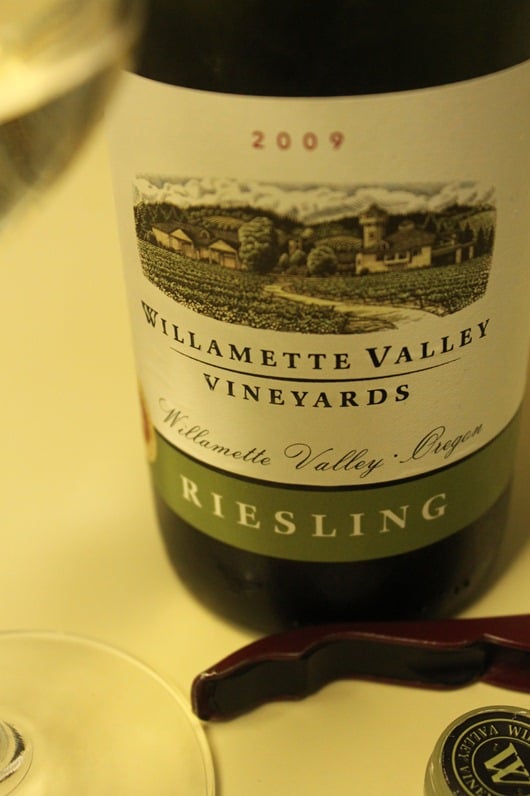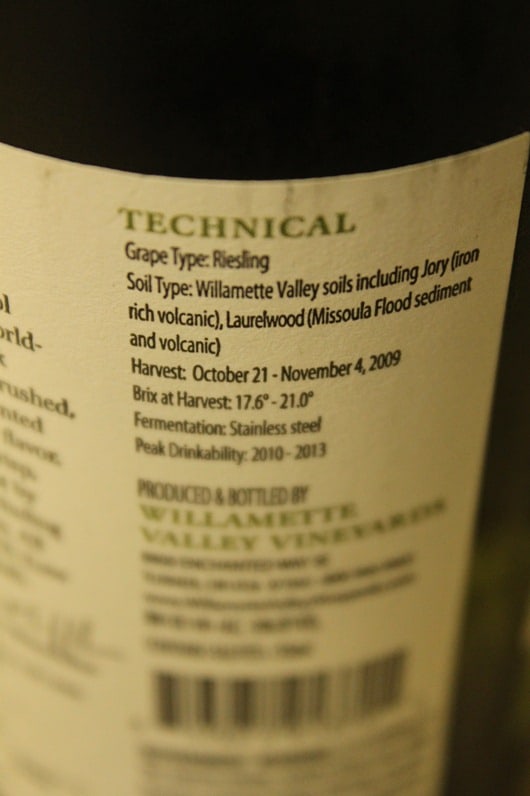
Grape
100% Riesling
Historical references to the Riesling grape can be traced back to Germany in the 15th century.
Facts
- I’ve been a fan of Willamette Valley Vineyards (“WVV” for the cool kids) for quite a while now. Yes, they’re certainly one of the largest Oregon producers (70,400 cases in 2010), but I feel WVV maintain a consistently favorable quality to price ratio. An attribute which I personally note is lacking in a number of Oregon wineries…
- Jim Bernau purchased the vineyards for WVV back in 1983. The land originally was originally home to a plum orchard and blackberry vines, and so he planted to Pinot Noir, Pinot Gris and Chardonnay. In the beginning, since he didn’t have irrigation built into the vineyard, Jim watered all the vines by hand (with the help of a few thousand feet of hose)!
- WVV currently make 6 different types of Pinot, a Chard, a Pinot Gris, and of course, this Riesling. It certainly isn’t how Oregon has made its name, but Riesling still ranks as the 4th most planted grape in Oregon (behind the aforementioned 3).
- Willamette Valley Vineyards are big advocates for sustainable agriculture, as are a great number of Oregon wineries. WVV have been certified sustainable through LIVE (Low Input Viticulture and Enology), and certified Salmon Safe since 1997.
The winery also offers ten cents for each empty bottle returned to their tasting room and $1 for returned shipped bottles. And as if all that wasn’t enough, in 2005 founder Jim Bernau started offering fifty gallons of biodiesel a month to each employee, as an incentive to switch to the green fuel, all at no cost. What a nice guy!

 Place
Place
- The Willamette Valley is Oregon’s largest wine producing region, measuring 150 miles in length, up to 60 miles in width, and home to over 200 wineries.
- It goes with out saying that Pinot Noir is the bread-and-butter of the Oregon wine industry with 12,406 planted acres (about 19 sq miles) in 2010. Pinot Gris trails far behind with 2,747 planted acres, and Chardonnay even further with 950 acres.
- As of 2010, there were 419 wineries in Oregon.
- WVV state that their terroir is very similar to that found in the Grand Cru French vineyards of Romaneé-St-Vivant. It’s also worth noting that if you look on a globe, Oregon does indeed share the same latitude as the Burgundy region of France.
- The winery and cellar at Willamette Valley Vineyards are set into the top of an ancient volcanic flow. The soil is still red from its oxidized iron content.

Taste
As the label above correctly indicates, the Willamette Valley Vineyards Riesling, yields a medium level of sweetness. Enough to keep the Riesling drinkers happy, and not so much that it makes the non-Riesling drinkers wince.
Pineapple, peach sorbet, ripe Granny Smith apple, Honey Dew melon, sherbet, and light minerality. Beautifully refreshing and balanced. The type of wine I could drink all whilst day sat by the pool.
Pairing
The beauty of Riesling (that edges toward a drier style), is that it can potentially lay claim to be one of the most dynamic food pairing wines available. Undisputed.
This is another wine that has no problem standing on its own two feet, but if you’re looking for a pairing suggestion, think about soft and mild cheeses, creamy chicken/seafood pasta, pork tenderloin, Thai, Cajun, Indian, and fruit-based desserts.
Price
$14


